Analysis of Asset Management Decision Making in Power Production
VerifiedAdded on 2021/05/31
|27
|7833
|65
Report
AI Summary
This report delves into the critical aspects of asset management within the power production industry, particularly focusing on the management of transformers. The study examines the significance of asset management in enhancing business performance and profit margins, especially for companies like SA Power Networks in Southern Australia. It explores key strategies such as Failure Modes and Effects Analysis (FMEA) to mitigate risks and ensure the reliability of transformers, which are vital components in power distribution. The report covers various facets of asset management including loss estimation, asset information, business KPIs, maintenance strategies, risk management, and the decision-making processes of asset managers. It highlights the importance of balancing financial considerations with the technical requirements of asset maintenance to optimize the lifespan and performance of transformers, ultimately aiming to minimize losses and maximize operational efficiency. The report also analyzes the aging of transformers, the role of Dissolved Gas Analysis (DGA), and the impact of factors like overloading on asset lifespan, emphasizing the importance of proactive maintenance and strategic decision-making in the power industry.
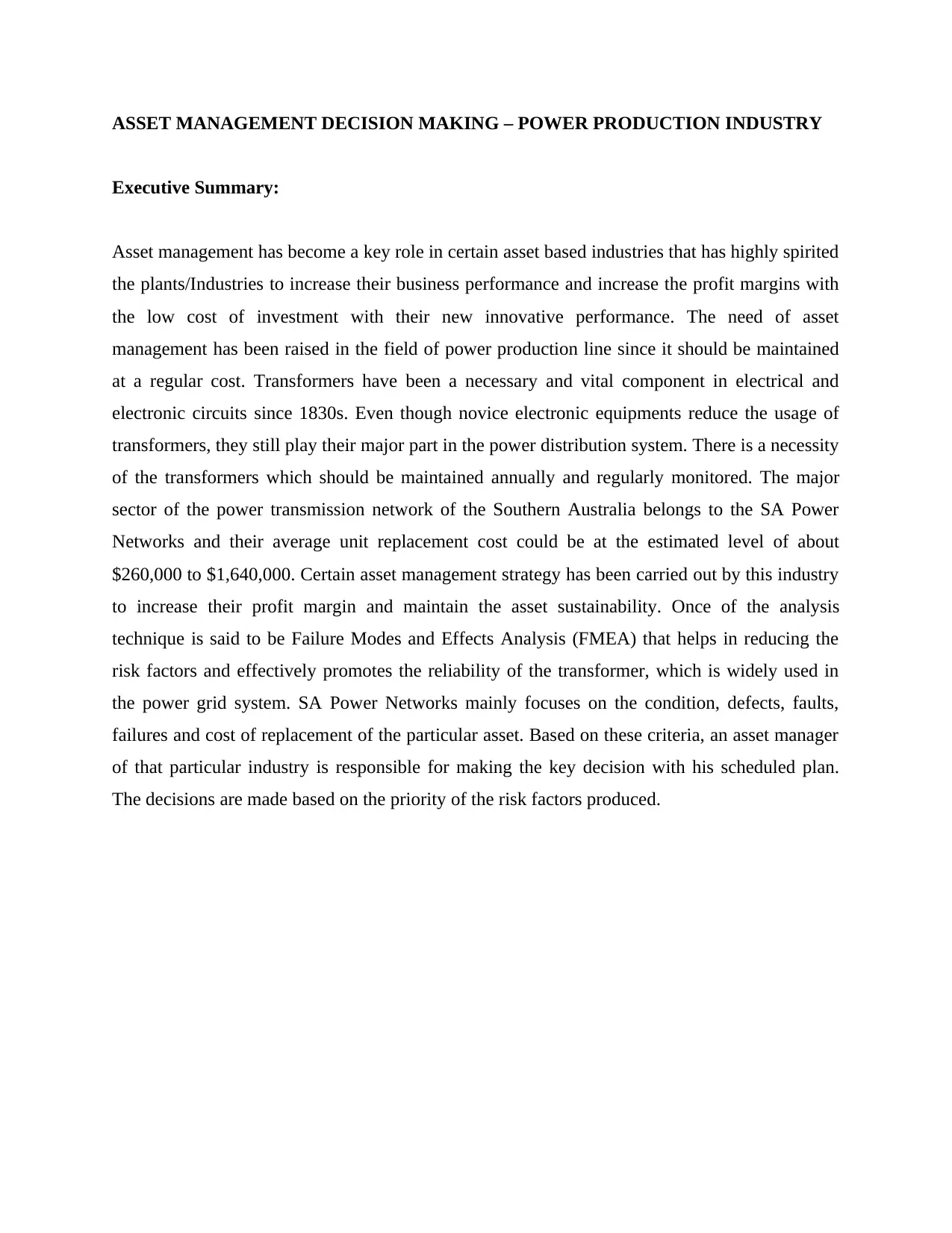
ASSET MANAGEMENT DECISION MAKING – POWER PRODUCTION INDUSTRY
Executive Summary:
Asset management has become a key role in certain asset based industries that has highly spirited
the plants/Industries to increase their business performance and increase the profit margins with
the low cost of investment with their new innovative performance. The need of asset
management has been raised in the field of power production line since it should be maintained
at a regular cost. Transformers have been a necessary and vital component in electrical and
electronic circuits since 1830s. Even though novice electronic equipments reduce the usage of
transformers, they still play their major part in the power distribution system. There is a necessity
of the transformers which should be maintained annually and regularly monitored. The major
sector of the power transmission network of the Southern Australia belongs to the SA Power
Networks and their average unit replacement cost could be at the estimated level of about
$260,000 to $1,640,000. Certain asset management strategy has been carried out by this industry
to increase their profit margin and maintain the asset sustainability. Once of the analysis
technique is said to be Failure Modes and Effects Analysis (FMEA) that helps in reducing the
risk factors and effectively promotes the reliability of the transformer, which is widely used in
the power grid system. SA Power Networks mainly focuses on the condition, defects, faults,
failures and cost of replacement of the particular asset. Based on these criteria, an asset manager
of that particular industry is responsible for making the key decision with his scheduled plan.
The decisions are made based on the priority of the risk factors produced.
Executive Summary:
Asset management has become a key role in certain asset based industries that has highly spirited
the plants/Industries to increase their business performance and increase the profit margins with
the low cost of investment with their new innovative performance. The need of asset
management has been raised in the field of power production line since it should be maintained
at a regular cost. Transformers have been a necessary and vital component in electrical and
electronic circuits since 1830s. Even though novice electronic equipments reduce the usage of
transformers, they still play their major part in the power distribution system. There is a necessity
of the transformers which should be maintained annually and regularly monitored. The major
sector of the power transmission network of the Southern Australia belongs to the SA Power
Networks and their average unit replacement cost could be at the estimated level of about
$260,000 to $1,640,000. Certain asset management strategy has been carried out by this industry
to increase their profit margin and maintain the asset sustainability. Once of the analysis
technique is said to be Failure Modes and Effects Analysis (FMEA) that helps in reducing the
risk factors and effectively promotes the reliability of the transformer, which is widely used in
the power grid system. SA Power Networks mainly focuses on the condition, defects, faults,
failures and cost of replacement of the particular asset. Based on these criteria, an asset manager
of that particular industry is responsible for making the key decision with his scheduled plan.
The decisions are made based on the priority of the risk factors produced.
Paraphrase This Document
Need a fresh take? Get an instant paraphrase of this document with our AI Paraphraser
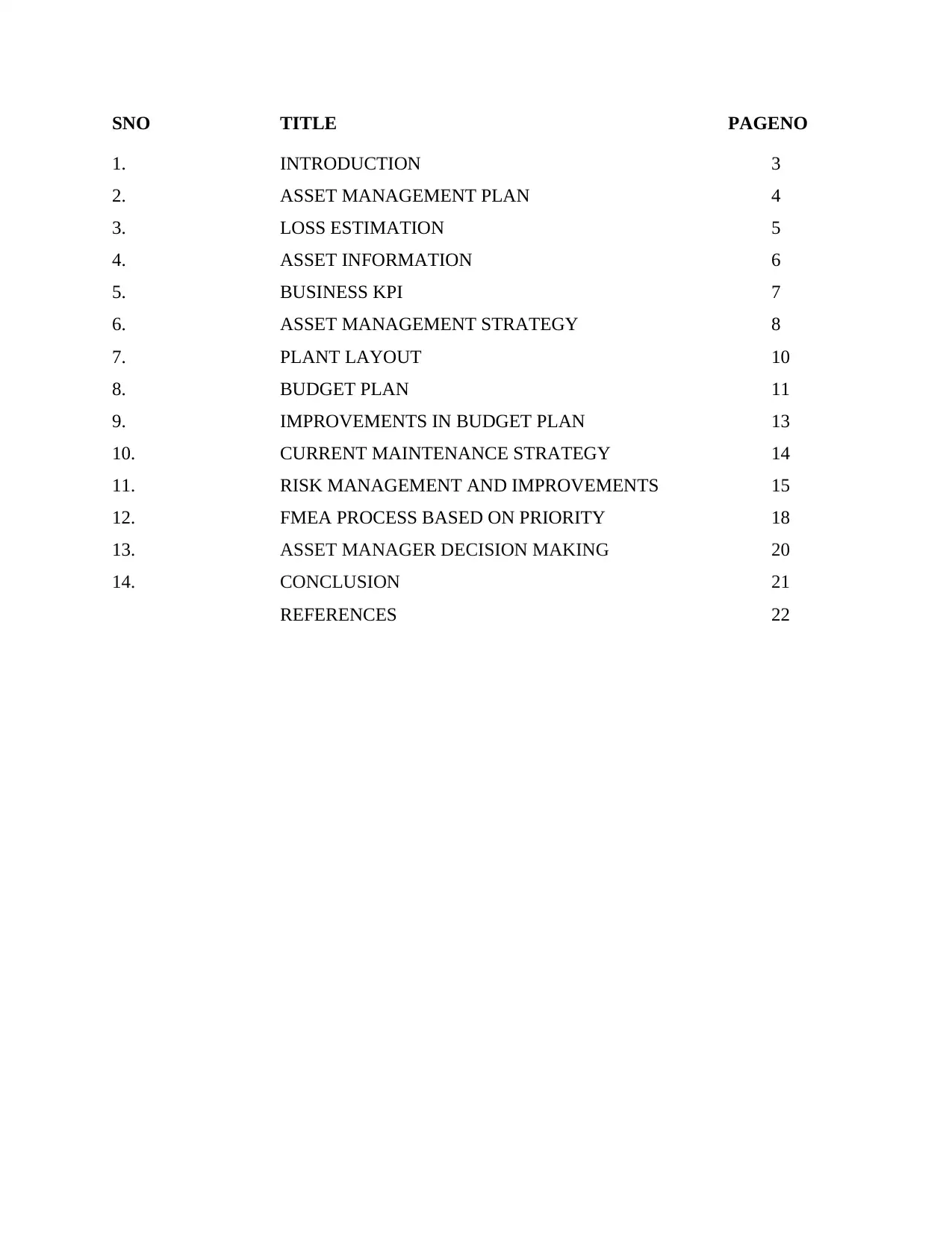
SNO TITLE PAGENO
1. INTRODUCTION 3
2. ASSET MANAGEMENT PLAN 4
3. LOSS ESTIMATION 5
4. ASSET INFORMATION 6
5. BUSINESS KPI 7
6. ASSET MANAGEMENT STRATEGY 8
7. PLANT LAYOUT 10
8. BUDGET PLAN 11
9. IMPROVEMENTS IN BUDGET PLAN 13
10. CURRENT MAINTENANCE STRATEGY 14
11. RISK MANAGEMENT AND IMPROVEMENTS 15
12. FMEA PROCESS BASED ON PRIORITY 18
13. ASSET MANAGER DECISION MAKING 20
14. CONCLUSION 21
REFERENCES 22
1. INTRODUCTION 3
2. ASSET MANAGEMENT PLAN 4
3. LOSS ESTIMATION 5
4. ASSET INFORMATION 6
5. BUSINESS KPI 7
6. ASSET MANAGEMENT STRATEGY 8
7. PLANT LAYOUT 10
8. BUDGET PLAN 11
9. IMPROVEMENTS IN BUDGET PLAN 13
10. CURRENT MAINTENANCE STRATEGY 14
11. RISK MANAGEMENT AND IMPROVEMENTS 15
12. FMEA PROCESS BASED ON PRIORITY 18
13. ASSET MANAGER DECISION MAKING 20
14. CONCLUSION 21
REFERENCES 22
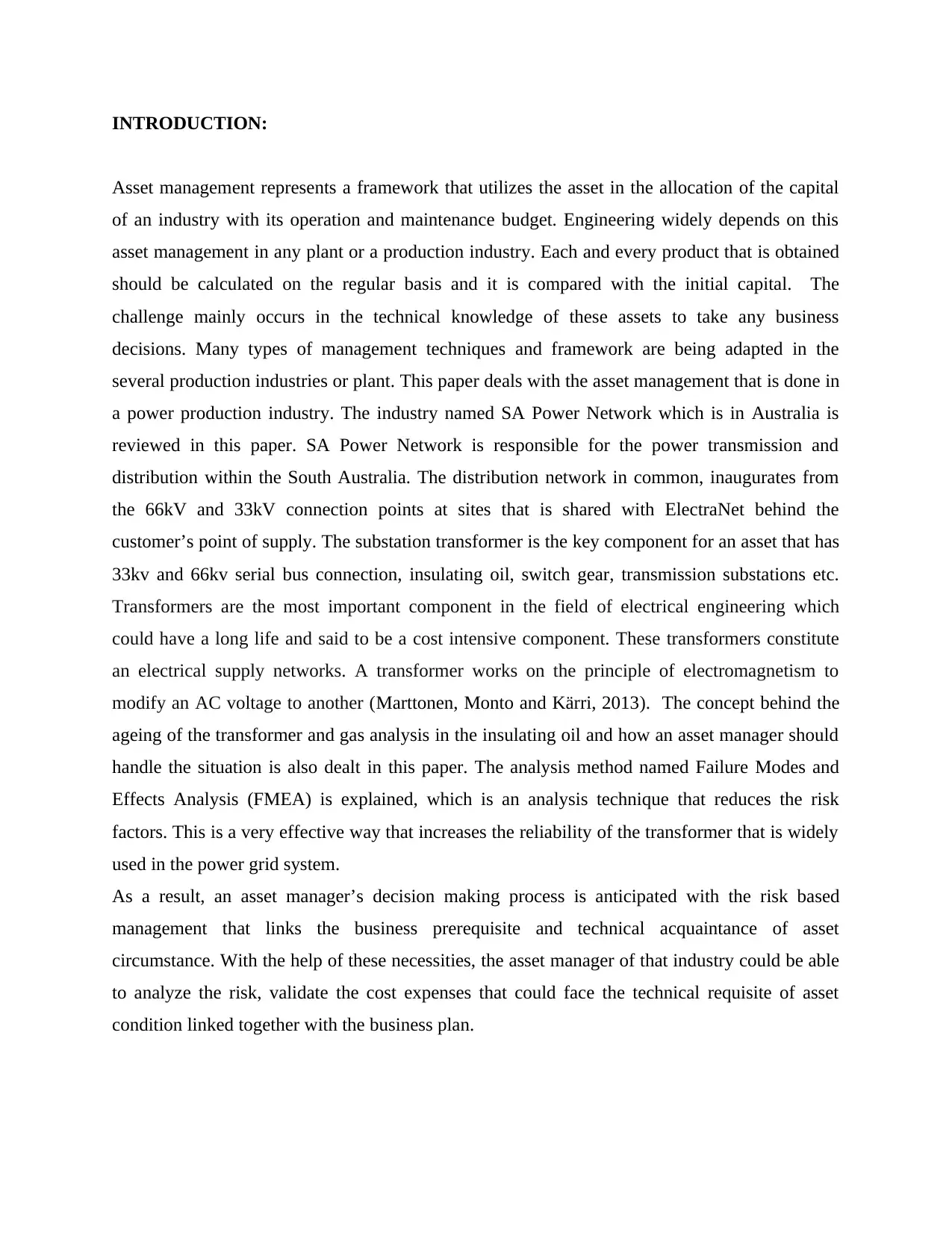
INTRODUCTION:
Asset management represents a framework that utilizes the asset in the allocation of the capital
of an industry with its operation and maintenance budget. Engineering widely depends on this
asset management in any plant or a production industry. Each and every product that is obtained
should be calculated on the regular basis and it is compared with the initial capital. The
challenge mainly occurs in the technical knowledge of these assets to take any business
decisions. Many types of management techniques and framework are being adapted in the
several production industries or plant. This paper deals with the asset management that is done in
a power production industry. The industry named SA Power Network which is in Australia is
reviewed in this paper. SA Power Network is responsible for the power transmission and
distribution within the South Australia. The distribution network in common, inaugurates from
the 66kV and 33kV connection points at sites that is shared with ElectraNet behind the
customer’s point of supply. The substation transformer is the key component for an asset that has
33kv and 66kv serial bus connection, insulating oil, switch gear, transmission substations etc.
Transformers are the most important component in the field of electrical engineering which
could have a long life and said to be a cost intensive component. These transformers constitute
an electrical supply networks. A transformer works on the principle of electromagnetism to
modify an AC voltage to another (Marttonen, Monto and Kärri, 2013). The concept behind the
ageing of the transformer and gas analysis in the insulating oil and how an asset manager should
handle the situation is also dealt in this paper. The analysis method named Failure Modes and
Effects Analysis (FMEA) is explained, which is an analysis technique that reduces the risk
factors. This is a very effective way that increases the reliability of the transformer that is widely
used in the power grid system.
As a result, an asset manager’s decision making process is anticipated with the risk based
management that links the business prerequisite and technical acquaintance of asset
circumstance. With the help of these necessities, the asset manager of that industry could be able
to analyze the risk, validate the cost expenses that could face the technical requisite of asset
condition linked together with the business plan.
Asset management represents a framework that utilizes the asset in the allocation of the capital
of an industry with its operation and maintenance budget. Engineering widely depends on this
asset management in any plant or a production industry. Each and every product that is obtained
should be calculated on the regular basis and it is compared with the initial capital. The
challenge mainly occurs in the technical knowledge of these assets to take any business
decisions. Many types of management techniques and framework are being adapted in the
several production industries or plant. This paper deals with the asset management that is done in
a power production industry. The industry named SA Power Network which is in Australia is
reviewed in this paper. SA Power Network is responsible for the power transmission and
distribution within the South Australia. The distribution network in common, inaugurates from
the 66kV and 33kV connection points at sites that is shared with ElectraNet behind the
customer’s point of supply. The substation transformer is the key component for an asset that has
33kv and 66kv serial bus connection, insulating oil, switch gear, transmission substations etc.
Transformers are the most important component in the field of electrical engineering which
could have a long life and said to be a cost intensive component. These transformers constitute
an electrical supply networks. A transformer works on the principle of electromagnetism to
modify an AC voltage to another (Marttonen, Monto and Kärri, 2013). The concept behind the
ageing of the transformer and gas analysis in the insulating oil and how an asset manager should
handle the situation is also dealt in this paper. The analysis method named Failure Modes and
Effects Analysis (FMEA) is explained, which is an analysis technique that reduces the risk
factors. This is a very effective way that increases the reliability of the transformer that is widely
used in the power grid system.
As a result, an asset manager’s decision making process is anticipated with the risk based
management that links the business prerequisite and technical acquaintance of asset
circumstance. With the help of these necessities, the asset manager of that industry could be able
to analyze the risk, validate the cost expenses that could face the technical requisite of asset
condition linked together with the business plan.
⊘ This is a preview!⊘
Do you want full access?
Subscribe today to unlock all pages.

Trusted by 1+ million students worldwide
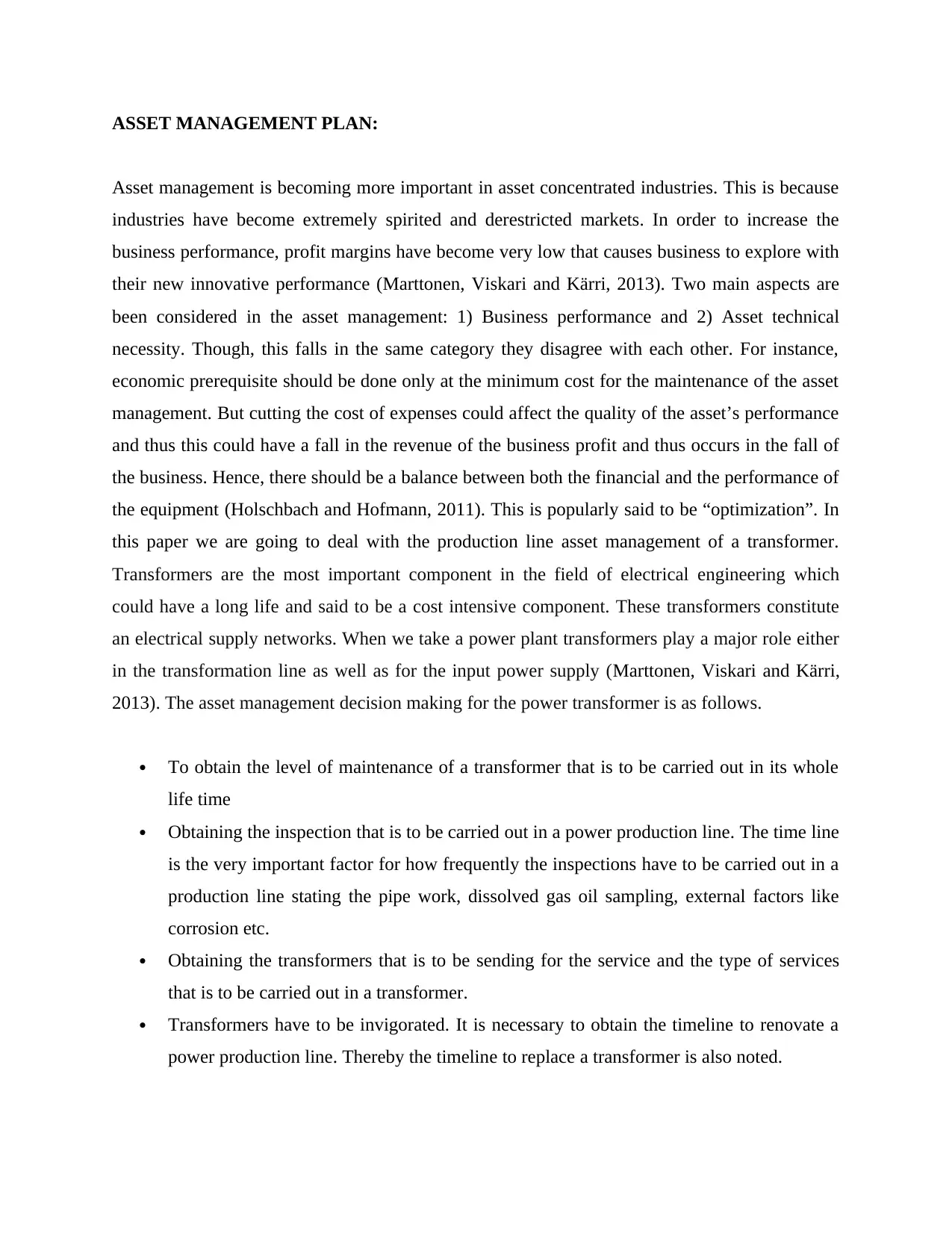
ASSET MANAGEMENT PLAN:
Asset management is becoming more important in asset concentrated industries. This is because
industries have become extremely spirited and derestricted markets. In order to increase the
business performance, profit margins have become very low that causes business to explore with
their new innovative performance (Marttonen, Viskari and Kärri, 2013). Two main aspects are
been considered in the asset management: 1) Business performance and 2) Asset technical
necessity. Though, this falls in the same category they disagree with each other. For instance,
economic prerequisite should be done only at the minimum cost for the maintenance of the asset
management. But cutting the cost of expenses could affect the quality of the asset’s performance
and thus this could have a fall in the revenue of the business profit and thus occurs in the fall of
the business. Hence, there should be a balance between both the financial and the performance of
the equipment (Holschbach and Hofmann, 2011). This is popularly said to be “optimization”. In
this paper we are going to deal with the production line asset management of a transformer.
Transformers are the most important component in the field of electrical engineering which
could have a long life and said to be a cost intensive component. These transformers constitute
an electrical supply networks. When we take a power plant transformers play a major role either
in the transformation line as well as for the input power supply (Marttonen, Viskari and Kärri,
2013). The asset management decision making for the power transformer is as follows.
· To obtain the level of maintenance of a transformer that is to be carried out in its whole
life time
· Obtaining the inspection that is to be carried out in a power production line. The time line
is the very important factor for how frequently the inspections have to be carried out in a
production line stating the pipe work, dissolved gas oil sampling, external factors like
corrosion etc.
· Obtaining the transformers that is to be sending for the service and the type of services
that is to be carried out in a transformer.
· Transformers have to be invigorated. It is necessary to obtain the timeline to renovate a
power production line. Thereby the timeline to replace a transformer is also noted.
Asset management is becoming more important in asset concentrated industries. This is because
industries have become extremely spirited and derestricted markets. In order to increase the
business performance, profit margins have become very low that causes business to explore with
their new innovative performance (Marttonen, Viskari and Kärri, 2013). Two main aspects are
been considered in the asset management: 1) Business performance and 2) Asset technical
necessity. Though, this falls in the same category they disagree with each other. For instance,
economic prerequisite should be done only at the minimum cost for the maintenance of the asset
management. But cutting the cost of expenses could affect the quality of the asset’s performance
and thus this could have a fall in the revenue of the business profit and thus occurs in the fall of
the business. Hence, there should be a balance between both the financial and the performance of
the equipment (Holschbach and Hofmann, 2011). This is popularly said to be “optimization”. In
this paper we are going to deal with the production line asset management of a transformer.
Transformers are the most important component in the field of electrical engineering which
could have a long life and said to be a cost intensive component. These transformers constitute
an electrical supply networks. When we take a power plant transformers play a major role either
in the transformation line as well as for the input power supply (Marttonen, Viskari and Kärri,
2013). The asset management decision making for the power transformer is as follows.
· To obtain the level of maintenance of a transformer that is to be carried out in its whole
life time
· Obtaining the inspection that is to be carried out in a power production line. The time line
is the very important factor for how frequently the inspections have to be carried out in a
production line stating the pipe work, dissolved gas oil sampling, external factors like
corrosion etc.
· Obtaining the transformers that is to be sending for the service and the type of services
that is to be carried out in a transformer.
· Transformers have to be invigorated. It is necessary to obtain the timeline to renovate a
power production line. Thereby the timeline to replace a transformer is also noted.
Paraphrase This Document
Need a fresh take? Get an instant paraphrase of this document with our AI Paraphraser

LOSS ESTIMATION:
In order to evaluate the loss that is caused due to the transformer, the life time of the transformer
is estimated by the commercial and the industrial owners. There is a necessity of the transformers
which should be maintained annually and it should be regularly monitored (Catelani, Ciani,
Cristaldi, Faifer, Lazzaroni and Rinaldi, 2011). In comparison, if the transformer is getting
replaced before its lifetime due to the failure that is caused due to the overloading, then the
expected loss could higher that estimated when compared. The power production grid could be
affected by many factors. It could be either the insulation fact that greatly reduces the life of the
transformer. It could the poor quality of the oil or the moisture content in a transformer or it
could be overloading factor too. This could be caused due to the extreme heat of the transformer,
which affects greatly in the insulation property. According to the nameplate reading,
transformers are designed to operate in a maximum life of 20 years. Transformers that are loaded
higher than the nameplate reading have a life of less than 20 years and the transformers that are
loaded lower than the nameplate reading have life more than 20 years.
The customer of the transformer should have a special contract with the manufacturer else, the
service time for replacing the transformer could be extended. Therefore, utilizing the transformer
to a maximum extend without any risk is extremely important (Hoseynabadi, Oraee and Tavner,
2010). It has become critical to study the lifetime models of the transformers, since 30
percentages of the transformer failures is caused due to the ageing. Heavy investments for the
transformer were made in the year of 1960-1970 that made the population of the transformer till
30 years. IEEE survey says that the ageing was caused in the transformer after the 25th year.
Therefore large transformers end their life at the 25th year and the replacement of the
transformers couldn’t be done all at once (Tavner, Higgins, Arabian, Long and Feng, 2010). This
becomes tedious and hence there occurs some cause of loss and this should be estimated and
tried to be avoided at a maximum extent.
In order to evaluate the loss that is caused due to the transformer, the life time of the transformer
is estimated by the commercial and the industrial owners. There is a necessity of the transformers
which should be maintained annually and it should be regularly monitored (Catelani, Ciani,
Cristaldi, Faifer, Lazzaroni and Rinaldi, 2011). In comparison, if the transformer is getting
replaced before its lifetime due to the failure that is caused due to the overloading, then the
expected loss could higher that estimated when compared. The power production grid could be
affected by many factors. It could be either the insulation fact that greatly reduces the life of the
transformer. It could the poor quality of the oil or the moisture content in a transformer or it
could be overloading factor too. This could be caused due to the extreme heat of the transformer,
which affects greatly in the insulation property. According to the nameplate reading,
transformers are designed to operate in a maximum life of 20 years. Transformers that are loaded
higher than the nameplate reading have a life of less than 20 years and the transformers that are
loaded lower than the nameplate reading have life more than 20 years.
The customer of the transformer should have a special contract with the manufacturer else, the
service time for replacing the transformer could be extended. Therefore, utilizing the transformer
to a maximum extend without any risk is extremely important (Hoseynabadi, Oraee and Tavner,
2010). It has become critical to study the lifetime models of the transformers, since 30
percentages of the transformer failures is caused due to the ageing. Heavy investments for the
transformer were made in the year of 1960-1970 that made the population of the transformer till
30 years. IEEE survey says that the ageing was caused in the transformer after the 25th year.
Therefore large transformers end their life at the 25th year and the replacement of the
transformers couldn’t be done all at once (Tavner, Higgins, Arabian, Long and Feng, 2010). This
becomes tedious and hence there occurs some cause of loss and this should be estimated and
tried to be avoided at a maximum extent.
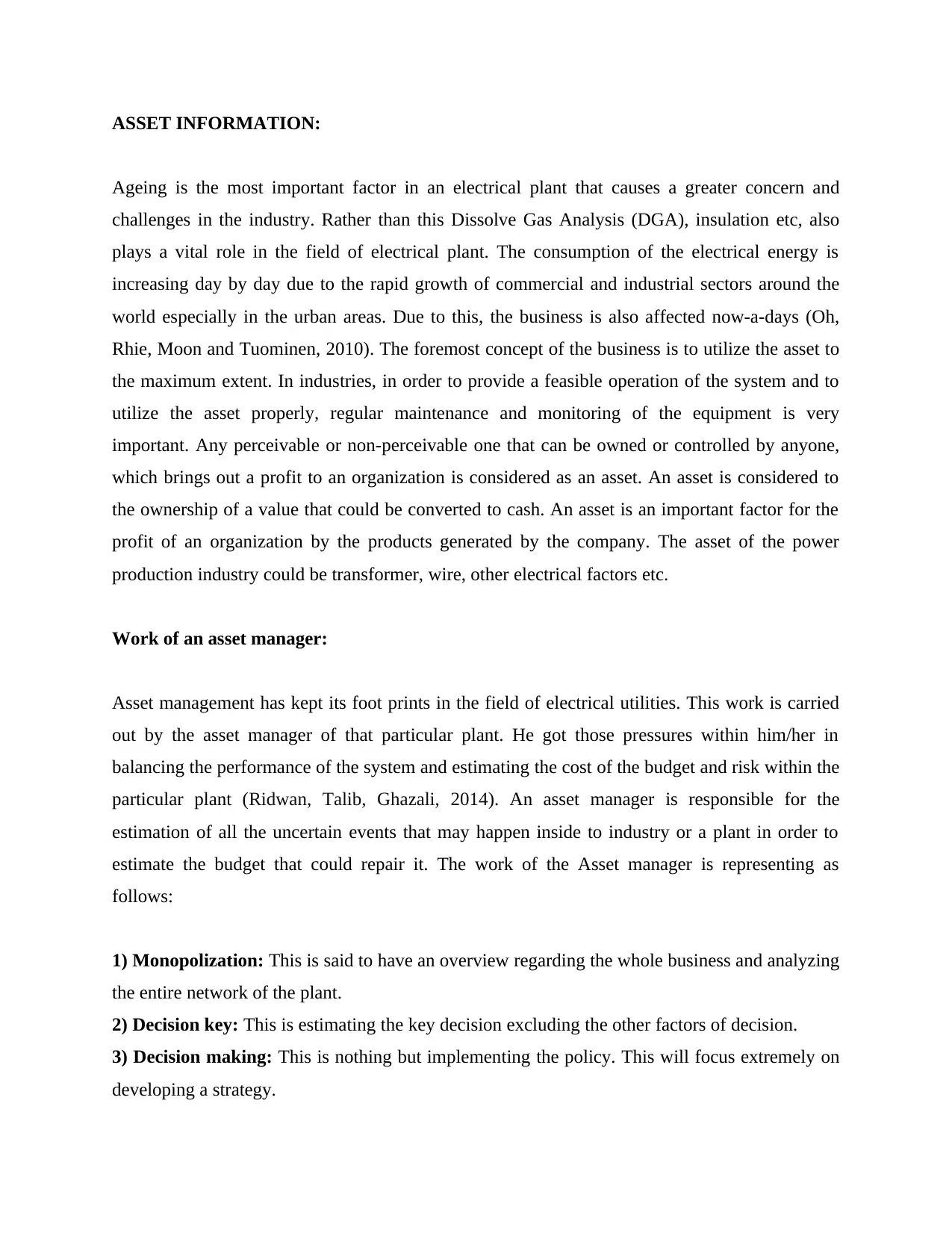
ASSET INFORMATION:
Ageing is the most important factor in an electrical plant that causes a greater concern and
challenges in the industry. Rather than this Dissolve Gas Analysis (DGA), insulation etc, also
plays a vital role in the field of electrical plant. The consumption of the electrical energy is
increasing day by day due to the rapid growth of commercial and industrial sectors around the
world especially in the urban areas. Due to this, the business is also affected now-a-days (Oh,
Rhie, Moon and Tuominen, 2010). The foremost concept of the business is to utilize the asset to
the maximum extent. In industries, in order to provide a feasible operation of the system and to
utilize the asset properly, regular maintenance and monitoring of the equipment is very
important. Any perceivable or non-perceivable one that can be owned or controlled by anyone,
which brings out a profit to an organization is considered as an asset. An asset is considered to
the ownership of a value that could be converted to cash. An asset is an important factor for the
profit of an organization by the products generated by the company. The asset of the power
production industry could be transformer, wire, other electrical factors etc.
Work of an asset manager:
Asset management has kept its foot prints in the field of electrical utilities. This work is carried
out by the asset manager of that particular plant. He got those pressures within him/her in
balancing the performance of the system and estimating the cost of the budget and risk within the
particular plant (Ridwan, Talib, Ghazali, 2014). An asset manager is responsible for the
estimation of all the uncertain events that may happen inside to industry or a plant in order to
estimate the budget that could repair it. The work of the Asset manager is representing as
follows:
1) Monopolization: This is said to have an overview regarding the whole business and analyzing
the entire network of the plant.
2) Decision key: This is estimating the key decision excluding the other factors of decision.
3) Decision making: This is nothing but implementing the policy. This will focus extremely on
developing a strategy.
Ageing is the most important factor in an electrical plant that causes a greater concern and
challenges in the industry. Rather than this Dissolve Gas Analysis (DGA), insulation etc, also
plays a vital role in the field of electrical plant. The consumption of the electrical energy is
increasing day by day due to the rapid growth of commercial and industrial sectors around the
world especially in the urban areas. Due to this, the business is also affected now-a-days (Oh,
Rhie, Moon and Tuominen, 2010). The foremost concept of the business is to utilize the asset to
the maximum extent. In industries, in order to provide a feasible operation of the system and to
utilize the asset properly, regular maintenance and monitoring of the equipment is very
important. Any perceivable or non-perceivable one that can be owned or controlled by anyone,
which brings out a profit to an organization is considered as an asset. An asset is considered to
the ownership of a value that could be converted to cash. An asset is an important factor for the
profit of an organization by the products generated by the company. The asset of the power
production industry could be transformer, wire, other electrical factors etc.
Work of an asset manager:
Asset management has kept its foot prints in the field of electrical utilities. This work is carried
out by the asset manager of that particular plant. He got those pressures within him/her in
balancing the performance of the system and estimating the cost of the budget and risk within the
particular plant (Ridwan, Talib, Ghazali, 2014). An asset manager is responsible for the
estimation of all the uncertain events that may happen inside to industry or a plant in order to
estimate the budget that could repair it. The work of the Asset manager is representing as
follows:
1) Monopolization: This is said to have an overview regarding the whole business and analyzing
the entire network of the plant.
2) Decision key: This is estimating the key decision excluding the other factors of decision.
3) Decision making: This is nothing but implementing the policy. This will focus extremely on
developing a strategy.
⊘ This is a preview!⊘
Do you want full access?
Subscribe today to unlock all pages.

Trusted by 1+ million students worldwide

4) Business network: The entire business must be taken into consideration rather than taking a
particular network.
5) Profit making: Business point of view is making a profit from the estimated asset and this
should be primarily a main focus that should be a long time profit. The maximization of the short
term profit for maximum years by saving the unrequited spending amount, could lead an
accountability of the long term profit.
6) Maximum level for service: The safety is the foremost consideration including the
environment safety and performance for the best delivery of the end product should be
maintained.
7) Risk Management: The 100 per cent efficiency couldn’t be guaranteed. But the maximum
acceptable level should be maintained that could save a company or an industry from any risk
factors.
BUSINESS KPI:
A business case or a process is to meet the requirement of client by collecting the related and
structured activity inside the industry or a plant, which promote a service or a product. Key
Performance Indicators (KPI) is said to be followed by many data driven organization that
motivates them in their efficiency. It is defined as the “measures that helps to monitor a
company’s performance by the manager and spot out the changes that could be done in order to
increase the efficiency”. The processes are designed in reducing the spending cost but increase in
the efficiency of the product or produce the profit from the increased efficiency (Jagers and
Tenbohlen, 2009). This could add value to the business case. Objective, source, performance
criteria and the action plan are the key roles to be performed to make a KPI meaningful. The
foremost endeavor of a business is, “utilization of the assets to a maximum extend. The business
clutches the assets regularly, which led to the production of higher revenue. However, the
condition could get worsen due to this. At the plant or in industries, regular monitoring and
control should be maintained, in order to utilize and sustain the asset properly. The investment in
this monitoring and management will prolong the life of the asset (Goodden, 2009). Hence, a
balancing act should be maintained that utilizes the asset at a maximum and lowering the cost to
the minimum, so that the business could be enhanced.
particular network.
5) Profit making: Business point of view is making a profit from the estimated asset and this
should be primarily a main focus that should be a long time profit. The maximization of the short
term profit for maximum years by saving the unrequited spending amount, could lead an
accountability of the long term profit.
6) Maximum level for service: The safety is the foremost consideration including the
environment safety and performance for the best delivery of the end product should be
maintained.
7) Risk Management: The 100 per cent efficiency couldn’t be guaranteed. But the maximum
acceptable level should be maintained that could save a company or an industry from any risk
factors.
BUSINESS KPI:
A business case or a process is to meet the requirement of client by collecting the related and
structured activity inside the industry or a plant, which promote a service or a product. Key
Performance Indicators (KPI) is said to be followed by many data driven organization that
motivates them in their efficiency. It is defined as the “measures that helps to monitor a
company’s performance by the manager and spot out the changes that could be done in order to
increase the efficiency”. The processes are designed in reducing the spending cost but increase in
the efficiency of the product or produce the profit from the increased efficiency (Jagers and
Tenbohlen, 2009). This could add value to the business case. Objective, source, performance
criteria and the action plan are the key roles to be performed to make a KPI meaningful. The
foremost endeavor of a business is, “utilization of the assets to a maximum extend. The business
clutches the assets regularly, which led to the production of higher revenue. However, the
condition could get worsen due to this. At the plant or in industries, regular monitoring and
control should be maintained, in order to utilize and sustain the asset properly. The investment in
this monitoring and management will prolong the life of the asset (Goodden, 2009). Hence, a
balancing act should be maintained that utilizes the asset at a maximum and lowering the cost to
the minimum, so that the business could be enhanced.
Paraphrase This Document
Need a fresh take? Get an instant paraphrase of this document with our AI Paraphraser
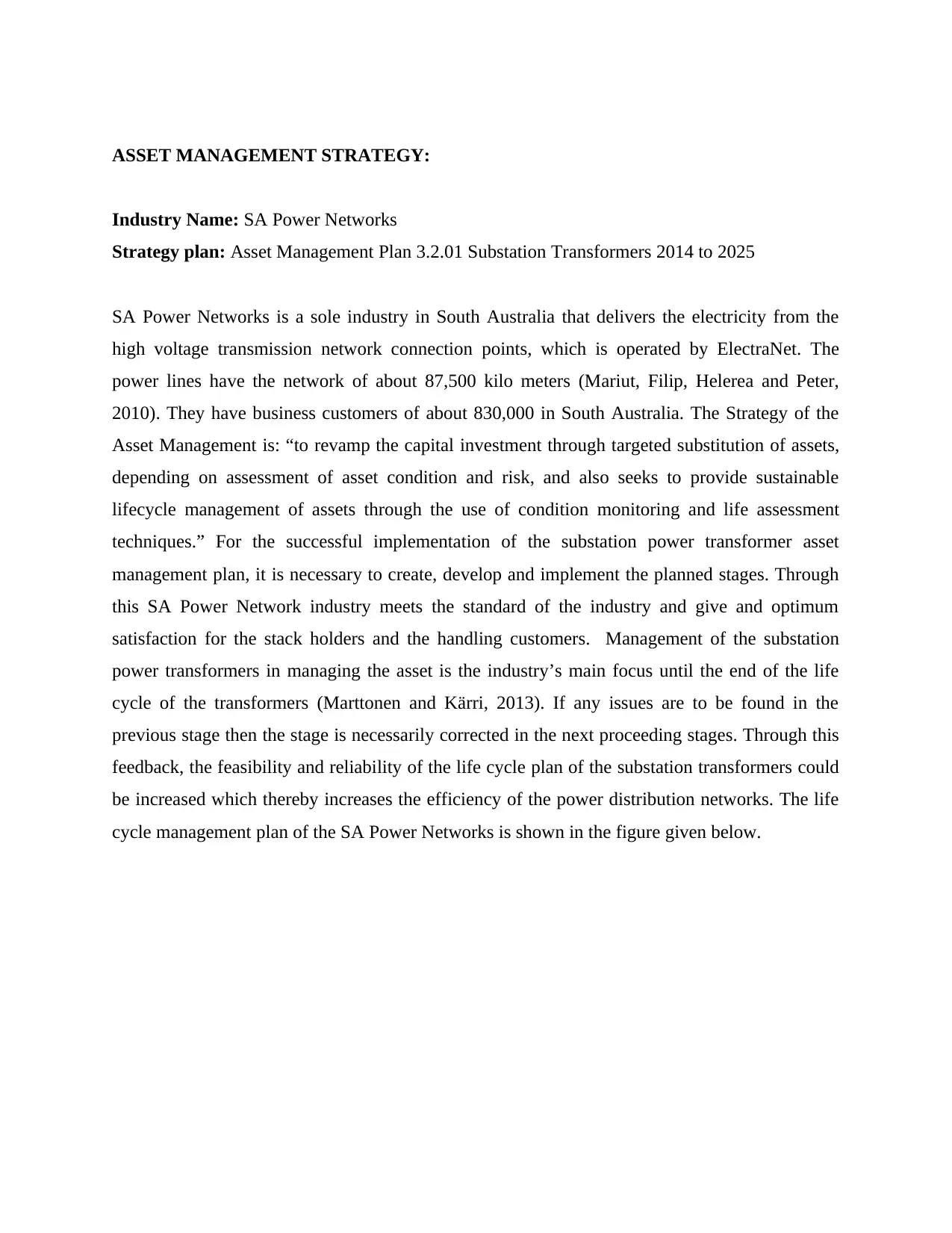
ASSET MANAGEMENT STRATEGY:
Industry Name: SA Power Networks
Strategy plan: Asset Management Plan 3.2.01 Substation Transformers 2014 to 2025
SA Power Networks is a sole industry in South Australia that delivers the electricity from the
high voltage transmission network connection points, which is operated by ElectraNet. The
power lines have the network of about 87,500 kilo meters (Mariut, Filip, Helerea and Peter,
2010). They have business customers of about 830,000 in South Australia. The Strategy of the
Asset Management is: “to revamp the capital investment through targeted substitution of assets,
depending on assessment of asset condition and risk, and also seeks to provide sustainable
lifecycle management of assets through the use of condition monitoring and life assessment
techniques.” For the successful implementation of the substation power transformer asset
management plan, it is necessary to create, develop and implement the planned stages. Through
this SA Power Network industry meets the standard of the industry and give and optimum
satisfaction for the stack holders and the handling customers. Management of the substation
power transformers in managing the asset is the industry’s main focus until the end of the life
cycle of the transformers (Marttonen and Kärri, 2013). If any issues are to be found in the
previous stage then the stage is necessarily corrected in the next proceeding stages. Through this
feedback, the feasibility and reliability of the life cycle plan of the substation transformers could
be increased which thereby increases the efficiency of the power distribution networks. The life
cycle management plan of the SA Power Networks is shown in the figure given below.
Industry Name: SA Power Networks
Strategy plan: Asset Management Plan 3.2.01 Substation Transformers 2014 to 2025
SA Power Networks is a sole industry in South Australia that delivers the electricity from the
high voltage transmission network connection points, which is operated by ElectraNet. The
power lines have the network of about 87,500 kilo meters (Mariut, Filip, Helerea and Peter,
2010). They have business customers of about 830,000 in South Australia. The Strategy of the
Asset Management is: “to revamp the capital investment through targeted substitution of assets,
depending on assessment of asset condition and risk, and also seeks to provide sustainable
lifecycle management of assets through the use of condition monitoring and life assessment
techniques.” For the successful implementation of the substation power transformer asset
management plan, it is necessary to create, develop and implement the planned stages. Through
this SA Power Network industry meets the standard of the industry and give and optimum
satisfaction for the stack holders and the handling customers. Management of the substation
power transformers in managing the asset is the industry’s main focus until the end of the life
cycle of the transformers (Marttonen and Kärri, 2013). If any issues are to be found in the
previous stage then the stage is necessarily corrected in the next proceeding stages. Through this
feedback, the feasibility and reliability of the life cycle plan of the substation transformers could
be increased which thereby increases the efficiency of the power distribution networks. The life
cycle management plan of the SA Power Networks is shown in the figure given below.
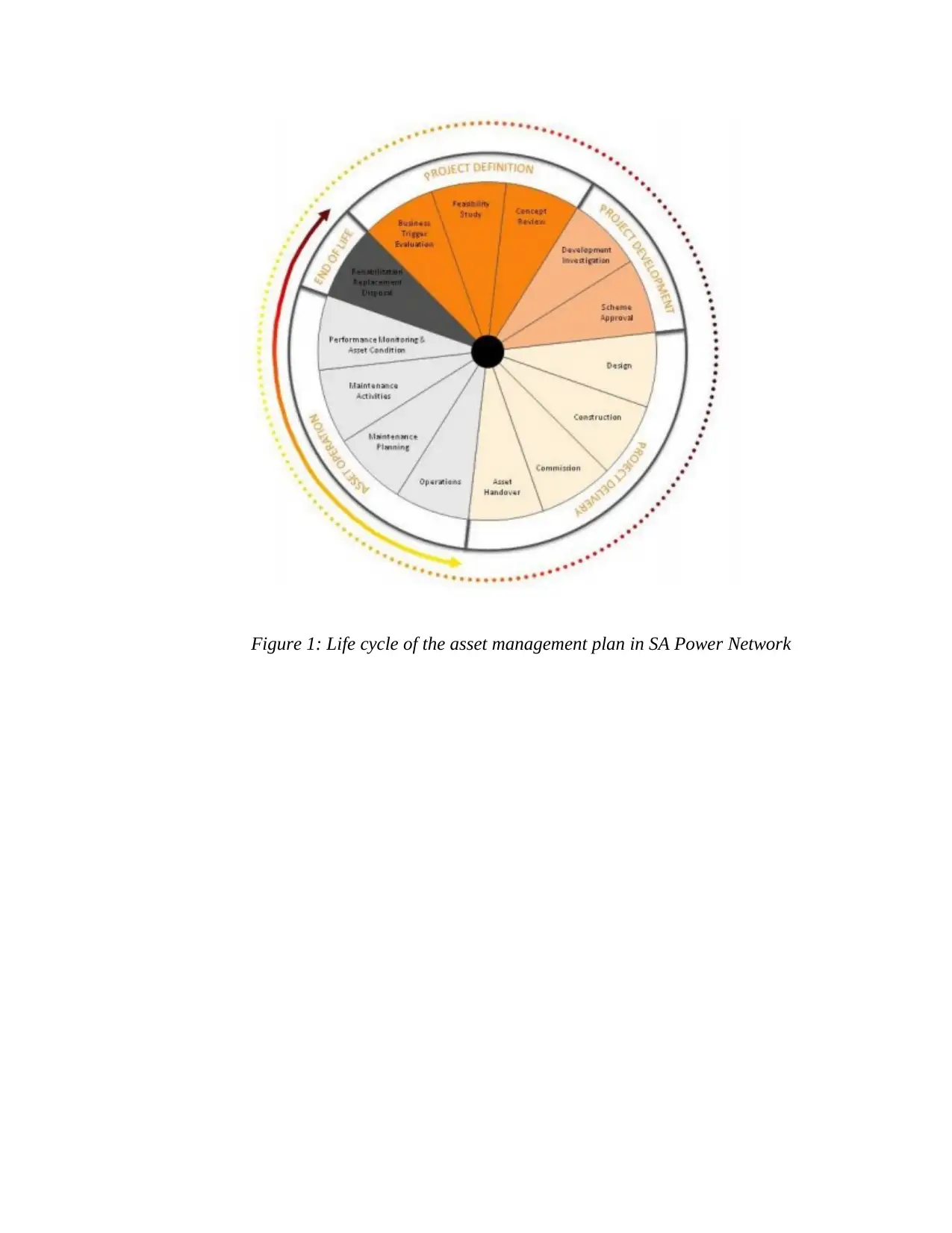
Figure 1: Life cycle of the asset management plan in SA Power Network
⊘ This is a preview!⊘
Do you want full access?
Subscribe today to unlock all pages.

Trusted by 1+ million students worldwide
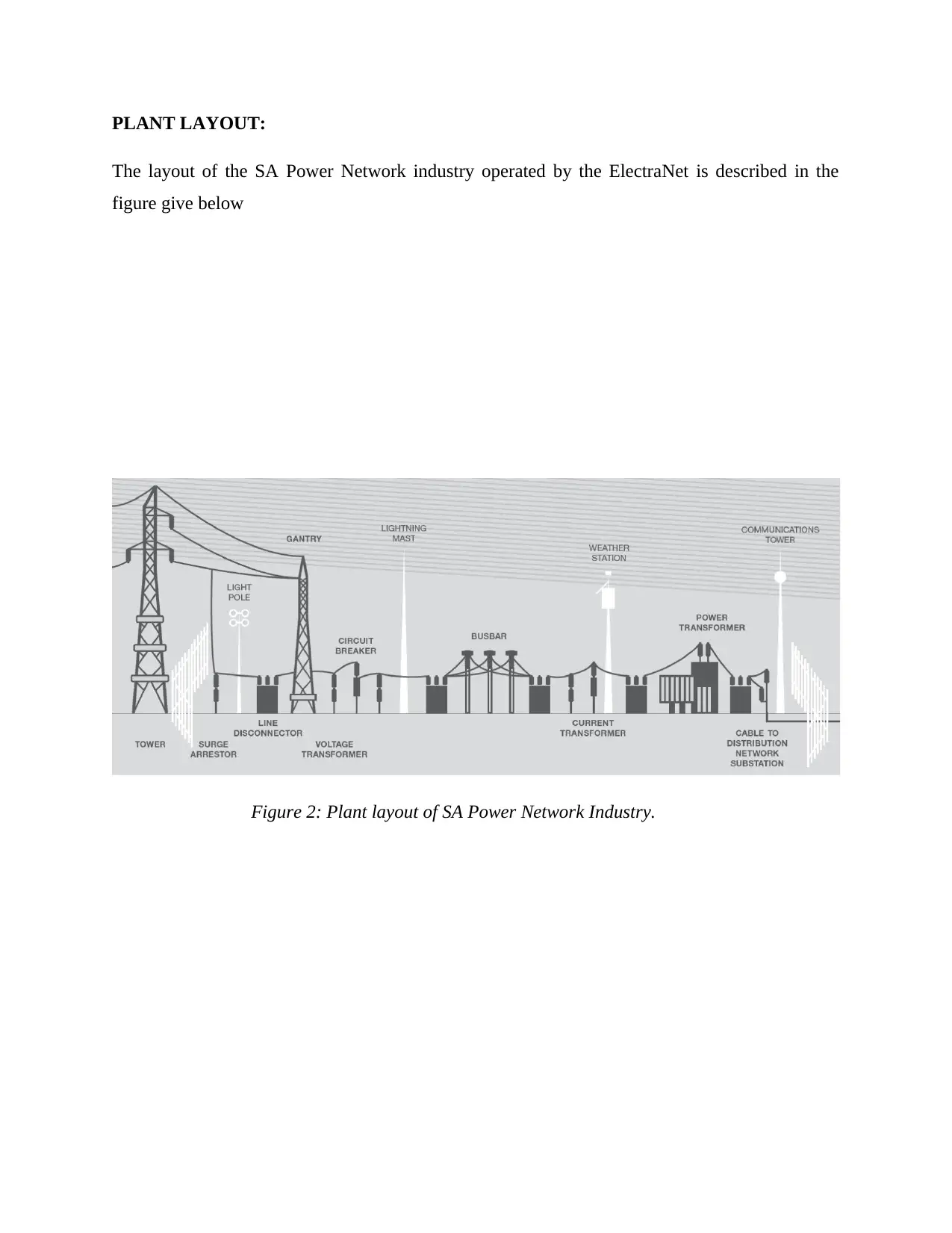
PLANT LAYOUT:
The layout of the SA Power Network industry operated by the ElectraNet is described in the
figure give below
Figure 2: Plant layout of SA Power Network Industry.
The layout of the SA Power Network industry operated by the ElectraNet is described in the
figure give below
Figure 2: Plant layout of SA Power Network Industry.
Paraphrase This Document
Need a fresh take? Get an instant paraphrase of this document with our AI Paraphraser
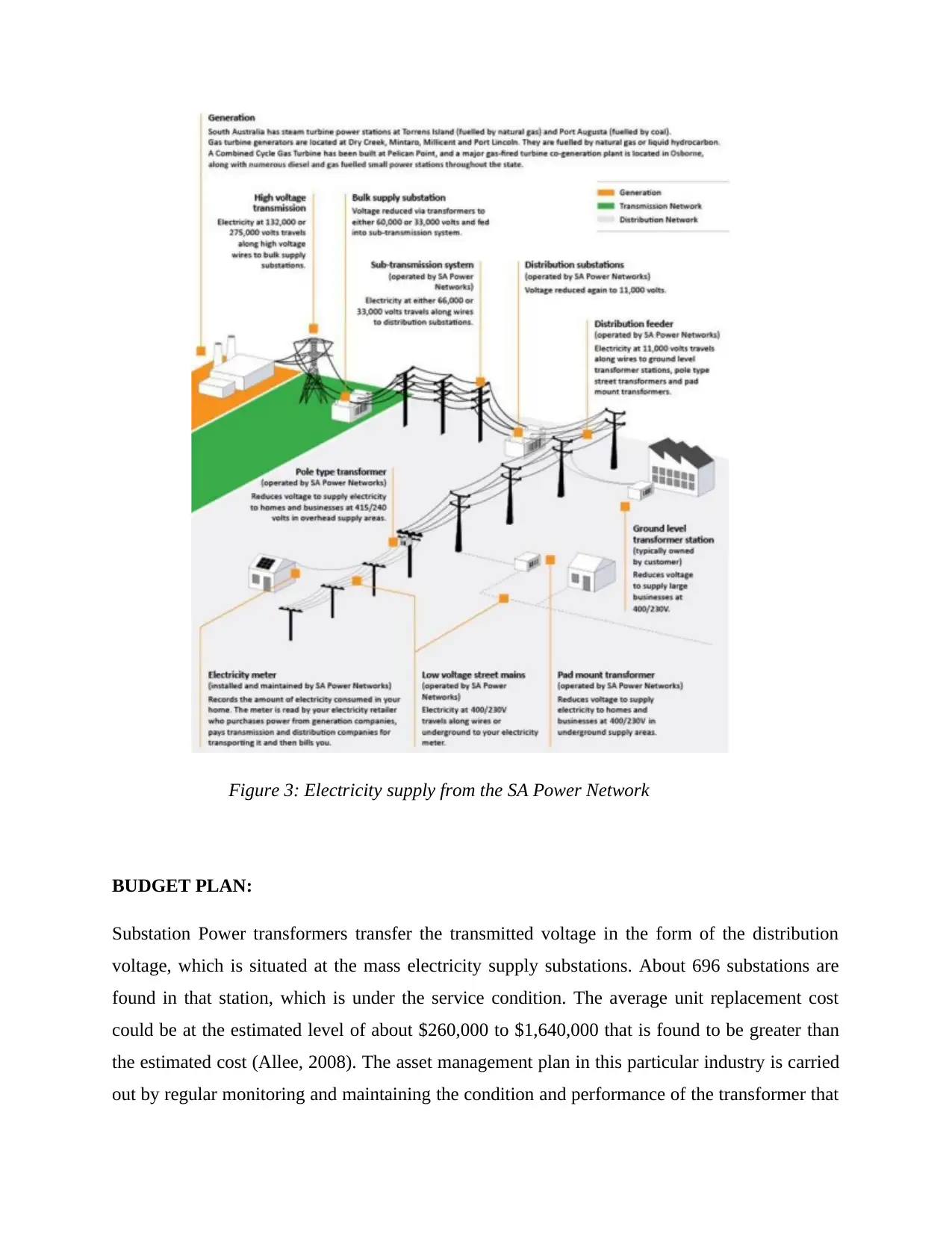
Figure 3: Electricity supply from the SA Power Network
BUDGET PLAN:
Substation Power transformers transfer the transmitted voltage in the form of the distribution
voltage, which is situated at the mass electricity supply substations. About 696 substations are
found in that station, which is under the service condition. The average unit replacement cost
could be at the estimated level of about $260,000 to $1,640,000 that is found to be greater than
the estimated cost (Allee, 2008). The asset management plan in this particular industry is carried
out by regular monitoring and maintaining the condition and performance of the transformer that
BUDGET PLAN:
Substation Power transformers transfer the transmitted voltage in the form of the distribution
voltage, which is situated at the mass electricity supply substations. About 696 substations are
found in that station, which is under the service condition. The average unit replacement cost
could be at the estimated level of about $260,000 to $1,640,000 that is found to be greater than
the estimated cost (Allee, 2008). The asset management plan in this particular industry is carried
out by regular monitoring and maintaining the condition and performance of the transformer that
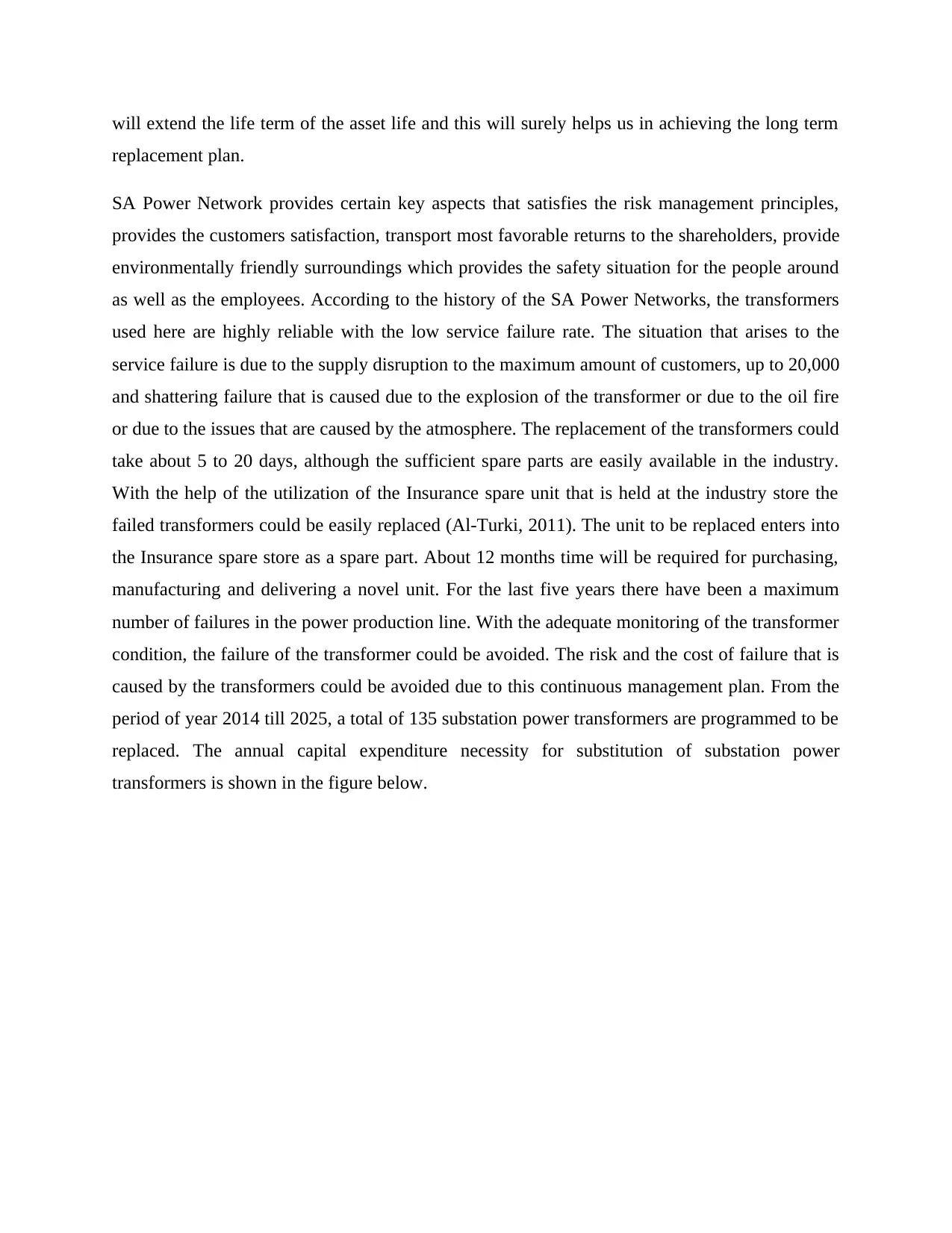
will extend the life term of the asset life and this will surely helps us in achieving the long term
replacement plan.
SA Power Network provides certain key aspects that satisfies the risk management principles,
provides the customers satisfaction, transport most favorable returns to the shareholders, provide
environmentally friendly surroundings which provides the safety situation for the people around
as well as the employees. According to the history of the SA Power Networks, the transformers
used here are highly reliable with the low service failure rate. The situation that arises to the
service failure is due to the supply disruption to the maximum amount of customers, up to 20,000
and shattering failure that is caused due to the explosion of the transformer or due to the oil fire
or due to the issues that are caused by the atmosphere. The replacement of the transformers could
take about 5 to 20 days, although the sufficient spare parts are easily available in the industry.
With the help of the utilization of the Insurance spare unit that is held at the industry store the
failed transformers could be easily replaced (Al-Turki, 2011). The unit to be replaced enters into
the Insurance spare store as a spare part. About 12 months time will be required for purchasing,
manufacturing and delivering a novel unit. For the last five years there have been a maximum
number of failures in the power production line. With the adequate monitoring of the transformer
condition, the failure of the transformer could be avoided. The risk and the cost of failure that is
caused by the transformers could be avoided due to this continuous management plan. From the
period of year 2014 till 2025, a total of 135 substation power transformers are programmed to be
replaced. The annual capital expenditure necessity for substitution of substation power
transformers is shown in the figure below.
replacement plan.
SA Power Network provides certain key aspects that satisfies the risk management principles,
provides the customers satisfaction, transport most favorable returns to the shareholders, provide
environmentally friendly surroundings which provides the safety situation for the people around
as well as the employees. According to the history of the SA Power Networks, the transformers
used here are highly reliable with the low service failure rate. The situation that arises to the
service failure is due to the supply disruption to the maximum amount of customers, up to 20,000
and shattering failure that is caused due to the explosion of the transformer or due to the oil fire
or due to the issues that are caused by the atmosphere. The replacement of the transformers could
take about 5 to 20 days, although the sufficient spare parts are easily available in the industry.
With the help of the utilization of the Insurance spare unit that is held at the industry store the
failed transformers could be easily replaced (Al-Turki, 2011). The unit to be replaced enters into
the Insurance spare store as a spare part. About 12 months time will be required for purchasing,
manufacturing and delivering a novel unit. For the last five years there have been a maximum
number of failures in the power production line. With the adequate monitoring of the transformer
condition, the failure of the transformer could be avoided. The risk and the cost of failure that is
caused by the transformers could be avoided due to this continuous management plan. From the
period of year 2014 till 2025, a total of 135 substation power transformers are programmed to be
replaced. The annual capital expenditure necessity for substitution of substation power
transformers is shown in the figure below.
⊘ This is a preview!⊘
Do you want full access?
Subscribe today to unlock all pages.

Trusted by 1+ million students worldwide
1 out of 27